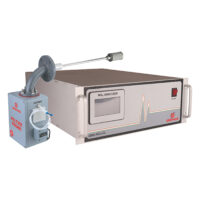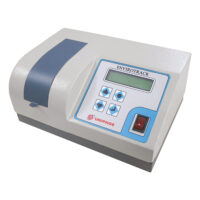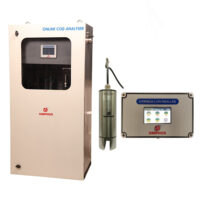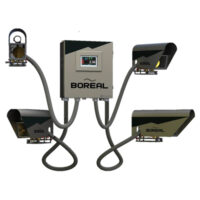Environmental Monitoring Equipment
Uniphos offers a wide range of monitoring equipment to measure levels of pollutants in stack emissions, air and water, providing the customer a plethora of options to choose from.
Monitoring of fumigants is of upmost important both for a successful fumigation and for the safety and personal health of those involved. The concentrations of fumigants need to be monitored inside the structure to ensure successful fumigation. Further, the fumigants are harmful, dangerous and fatal to people. To prevent accidental entry of personnel in areas that have been fumigated and have not vented properly.
Few of the gases that are used as fumigants are:
- Phosphine and Sulfuryl Fluoride, which are both extremely toxic
- Methyl bromide, which apart from being toxic also depletes the ozone layer.
The main reasons that we need to detect and/or monitor fumigants are
For personal safety and protection
Poor warehouse design, uneven stack, or defective fumigation covers can cause leakage of the fumigants from the fumigated space and thus causing fumigation failure. Even minimal inhalation of these fumigants by working personnel can cause a feeling of sickness, nausea, and tightness in the chest, and extended exposure can have long term negative effects on their health. Hence checking for leaks during the entire fumigation period is of utmost importance for personal safety and protection. Here one needs to monitor fumigant levels in the TLV levels, which are in the sub-ppm or low-ppm levels.
For process control measurement
The fumigant is supposed to be confined for the intended duration of exposure at a pre-defined concentration to achieve the lethal dose needed to control the target pests in Containers, Bulk storages, Silos, etc. To ensure successful fumigation, the need to continuously monitor the gas concentration of Fumigants in the fumigated area is of utmost importance. Here one needs to monitor fumigant levels in lethal concentration levels, which are in hundreds and thousands of ppm.
FAQ's
What is environmental monitoring?
Environmental monitoring, particularly in the context of air and water quality, refers to the systematic process of observing, assessing, and recording various parameters related to the composition and condition of the air and water. It involves utilizing specialized equipment and technologies to measure pollutants, gases, particulate matter, and other factors that can impact the quality of the air and water.
By gathering accurate data through various monitoring devices like gas detectors, particulate monitors, and analyzers, environmental monitoring helps us understand the levels of pollutants and their potential effects on human health and the environment. This data-driven approach aids in identifying pollution sources, evaluating compliance with air quality standards, and formulating effective mitigation strategies.
What is the main objective of environmental monitoring?
The primary goal of environmental monitoring, specifically in relation to air quality, is to systematically gather and analyze data to assess the state of the air in a given area. This process involves measuring various pollutants present in the atmosphere, such as sulfur dioxide, nitrogen dioxide, volatile organic compounds, and more.
Similarly, assessing water quality includes the examination of parameters like pH, dissolved oxygen, heavy metal concentrations, and microbial content. By understanding the composition of the air and water and how they may be changing over time, we can make informed decisions and take proactive steps to reduce pollution, minimize health hazards, and maintain a sustainable environment for present and future generations.
What are environmental monitoring systems?
Environmental monitoring systems refer to a network of devices and technologies designed to track and assess the quality of the air and water in a specific area. It involves the continuous measurement of various air and water pollutants. These monitoring systems employ a range of instruments, including sensors, analyzers, and data loggers, to gather real-time data on air and water quality.
The collected data is then analyzed to provide insights into pollution levels, potential health risks, and the overall environmental impact. By monitoring air and water quality over time, these systems contribute to informed decision-making, enabling governments, industries, and communities to take proactive measures to reduce pollution and protect public health.
How accurate is the environmental monitoring system?
The accuracy of environmental monitoring systems varies depending on the system’s design and calibration. When focusing on air quality and water quality monitoring, the monitoring system can provide highly accurate data. These systems use advanced sensors to detect various air and water pollutants and parameters such as particulate matter, volatile organic compounds, carbon dioxide, and temperature.
Factors like sensor quality, calibration frequency, and maintenance influence the accuracy of air and water quality measurements. Regular calibration ensures precise readings. EMS offers real-time insights into air and water quality, alerting users to any deviations from set parameters. It is particularly valuable in settings like laboratories, where maintaining specific air and water quality conditions is crucial for experiments and equipment operation.
Who uses environmental monitoring equipment?
Environmental monitoring systems, specifically focused on air and water quality, are utilized by various stakeholders. Government agencies rely on these systems to assess and manage air and water quality, ensuring compliance with environmental regulations and safeguarding public health.
Industries implement monitoring equipment to monitor emissions and maintain environmentally friendly operations. Research institutions and academics utilize these systems to study air and water quality and their impact on climate change.
Also, individuals and communities benefit from personal air and water quality monitors, enabling them to make informed decisions about outdoor activities and protect themselves from potential health hazards. Additionally, environmental activists use monitoring data to advocate for cleaner air and water policies and raise awareness about pollution issues.
What factors should be considered when selecting environmental monitoring systems?
When selecting an environmental monitoring system, several critical factors should be taken into consideration. Accuracy and reliability are of utmost importance, ensuring precise data on pollutants, temperature, and humidity. It’s essential that the system can be easily calibrated and maintained to guarantee consistent and dependable results.
Also, compatibility with existing equipment and software, real-time monitoring capabilities, and cost-effectiveness with desired features are some of the important factors to be considered when selecting environmental monitoring systems. Water quality is another crucial aspect that should not be overlooked, with the system’s ability to measure and analyze water parameters, such as pH, dissolved oxygen, and contaminants, being paramount.







